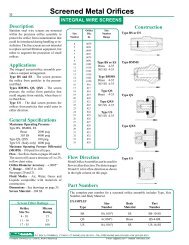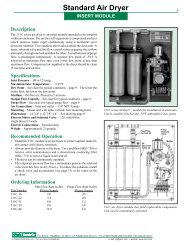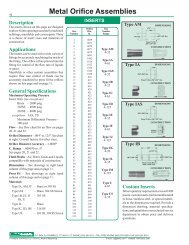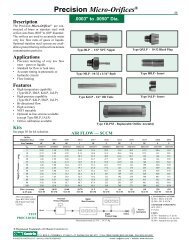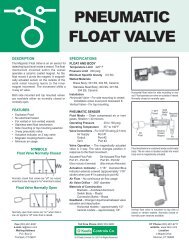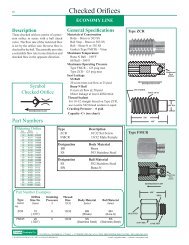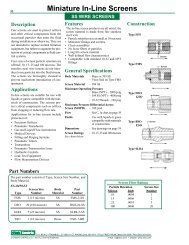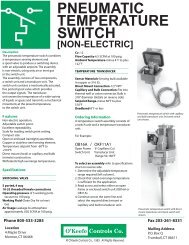Metal Orifice Assemblies - O'Keefe Controls Inc
Metal Orifice Assemblies - O'Keefe Controls Inc
Metal Orifice Assemblies - O'Keefe Controls Inc
You also want an ePaper? Increase the reach of your titles
YUMPU automatically turns print PDFs into web optimized ePapers that Google loves.
Calibrated <strong>Orifice</strong>s<br />
WATER OR AIR FLOW<br />
49<br />
Air Flow<br />
For flow standards or other critical uses,<br />
<strong>O'Keefe</strong> <strong>Controls</strong> Co. can provide measured<br />
air flow data for any of the standard precision<br />
orifice products. This optional service<br />
is available at a nominal charge and can be<br />
provided for pressure or vacuum flow conditions<br />
in the standard ranges listed below.<br />
A calibration sheet with measured data is<br />
provided for each orifice (see sample below).<br />
Data is obtained using a digital mass flowmeter<br />
traceable to the National Institute of<br />
Standards Technology (NIST). Standard<br />
conditions are 70ºF and 14.7 psia<br />
(See photo page 45).<br />
Air flow can be measured for any of the<br />
following conditions:<br />
Pressure 0-5, 0-10, 0-20, 0-50, 0-100 psig<br />
Vacuum 0-30" Hg<br />
Flow 0-.002, 0-.01, 0-.02, 0-.05,<br />
0-.1, 0-.2, 0-.5, 0-1, 0-2, 0-5,<br />
0-10, 0-20, 0-50, 0-200 SLPM<br />
Flow 0-.004, 0-.02, 0-.04, 0-.10,<br />
0-.2, 0-.4, 0-1, 0-2, 0-4, 0-10,<br />
0-20, 0-40, 0-100, 0-400 SCFH<br />
C v Measurement<br />
Water at a constant height equivalent to 1 psig is<br />
used to determine the amount of water that passes<br />
through a test orifice in a measured time period.<br />
The C v is calculated from the measured data.<br />
Water Flow<br />
Calibration of standard orifices using water<br />
flow is accomplished by measuring the<br />
quantity of water flowing through an orifice<br />
in a given time period at a specific inlet<br />
pressure.<br />
The calibration procedure determines the<br />
water flow rate through the orifice and the<br />
corresponding C v of the orifice is calculated.<br />
The C v can then be used to predict<br />
the water flow rate at varying differential<br />
pressure conditions using the equation:<br />
Q = C v<br />
∆P<br />
For liquids other than water flow rate can<br />
also be predicted using the C v method. See<br />
page 47 for details on liquid flow - C v<br />
method.<br />
A calibration sheet with measured data is<br />
provided for each orifice. The calculated C v<br />
is the average value computed from five<br />
separate tests (see sample below).<br />
P.O. BOX Q • TRUMBULL, CT 06611 • CT PHONE (203) 261-6711 • TOLL FREE PHONE (800) 533-3285 • FAX (203) 261-8331<br />
© O'KEEFE CONTROLS CO. • 2003 ALL RIGHTS RESERVED e-mail ca@okcc.com • website www.okcc.com




